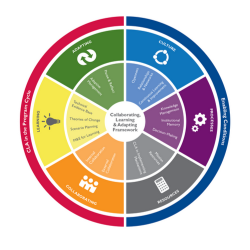Exploring the CLA Framework
This blog is the introduction to an ongoing series exploring the components of USAID's CLA Framework. Here is the first blog on organizational culture, the second on effective learning, the third on the resources necessary for CLA to take hold, and the fourth on effective collaboration.
For those of you who read the October 2015 edition of Learning Lab’s Learning Matters newsletter, hopefully you noticed the promo for the Collaborating, Learning, and Adapting (CLA) Maturity Matrix. If you didn’t see the post, the CLA Maturity Matrix is “a new tool being developed to provide a clear picture of what systematic, intentional, and resourced integration of CLA is throughout the USAID Program Cycle and within an organization's culture and processes.” The Matrix is based on a framework that stresses the holistic and integrated nature of the various components of CLA.

PPL and its LEARN mechanism have been working on this framework for nearly a year, and began by digesting USAID’s work on CLA since 2010, documenting and analyzing the examples of CLA to understand what it has looked like. We did additional stocktaking with 14 missions and with implementing partners to gain an even deeper understanding of what good CLA looks like on the ground.
In the simplest terms, the framework asks us to consider:
- Are we collaborating with the right partners at the right time to promote synergy over stovepiping?
- Are we asking the most important questions and finding answers that are relevant to decision making?
- Are we using the information that we gather through collaboration and learning activities to make better decisions and make adjustments as necessary?
- Are we working in an organizational environment that supports our collaborating, learning and adapting efforts?
The CLA framework disentangles the various components of CLA to help you think more deliberately about what approach to CLA might be best tailored to your organizational or project context. The components include:
Collaborating: When we talk about collaboration what we really want to know is whether we working with the right people at the right time for the right reason. Are we being deliberate and intentional about which partners we are engaging, and how?
Culture: In order to create the space for and get the most out of collaboration, there needs to be a culture that supports it. A culture that values openness, relationship-building, and continuous learning will be more likely to create opportunities for collaboration and continuous improvement through adaptive management.
Learning: A commitment to continuous improvement must be grounded by broad contextual awareness as well as a deep understanding of the questions that matter most, but it would be unreasonable to try to keep on top of every new development relevant to a local context or technical sector. Creating a learning agenda is one way to decide on priority questions and consider how monitoring, evaluation, and other types of analysis can help answer those questions.
Processes: The question then becomes, once we have learned something, what do we do with it? What processes are in place to make sure we go from documenting our knowledge to actually acting upon it? Having clearly articulated processes for things like decision making can help.
Adapting: One approach to determining what to do with new learning is to deliberately take time out to pause and reflect. This can happen in a number of ways, and who participates will depend on what you are trying to achieve, but it helps to consider how the activity advances your learning agenda and when you need to surface lessons so they can feed into design and implementation schedules.
Resources: CLA takes resources, including financial resources for things like space, travel, and probably most importantly, staff time. It also requires having staff and consultants with the skills necessary to help us collaborate intentionally, learn systematically, and manage adaptively.
The framework remains a work in progress. As we continue to develop it, we are practicing what we preach in terms of piloting, collecting feedback, and iterating. What remains constant, though, is that the framework and related CLA Maturity Matrix celebrate the diversity of what CLA can look like in various missions and projects, but still gives CLA structure, clarity, and coherence.
This post was written by Lauren Leigh Hinthorne, Monalisa Salib, and Jessica Ziegler.



